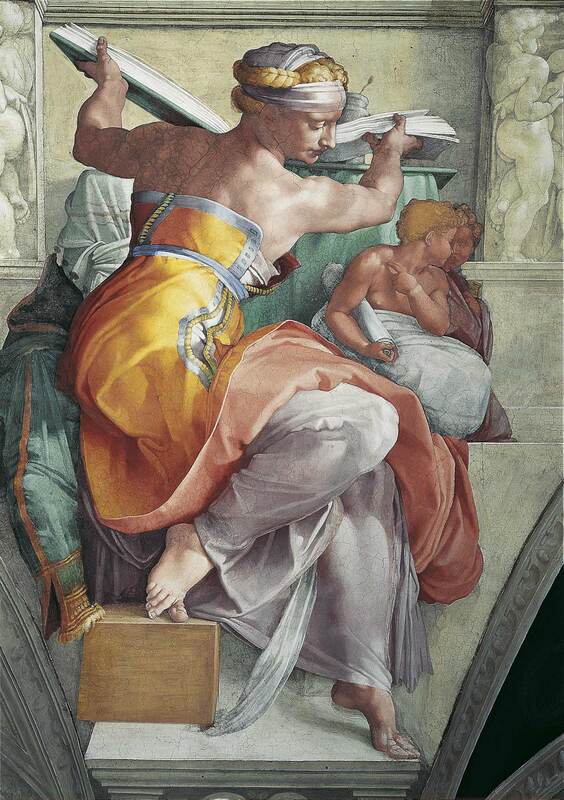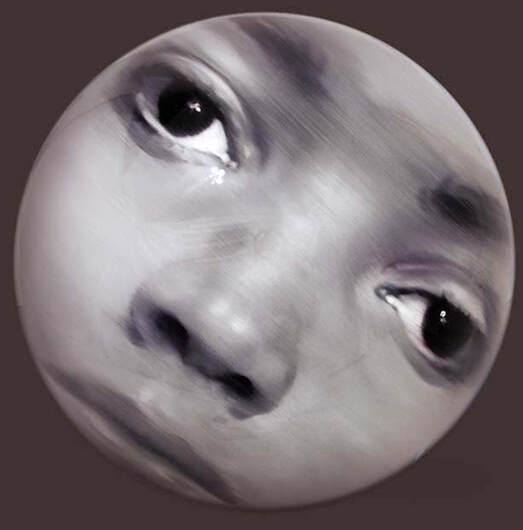RE-RENAISSANCE | CONCEPT
Lorenzo Lotto, portrait of a young man, 1526, detail (foto: wikipedia)
My great interest in the art of the Italian Renaissance is based on my enthusiasm for its achievements in the representation of man. From early on I was fascinated almost exclusively by the expressive power of the portrait paitings of that time and less interested in the person of the sitters or in the biographies of their painters. My focus was on the self-evident and inexplicable presence that these images possessed and conveyed, the vividness that they preserved for centuries. The expression of the sitters showed proud self-confidence proving their position as individuals. The subtle and never flat realism of the artistic representation allowed to perceive the human as something very natural but at the same time precious.
My admiration for Italian Renaissance painting has led to the desire to deal artistically with a few masterpieces focusing on two main aspects of this art epoch: Beauty and Innovation.
The discovery of works of art of the classical age gave Italian artists a decisive impetus during the economic and intellectual awakening of the 15th and 16th centuries. But they not only admired, but also transformed and charged with contemporaneity and new meaning.
I had to do the same. If I wanted to deal with 'beauty' in the first part of my Renaissance series, it could only be fruitful with awareness of the historical distance of centuries and creative appropriation.
The discovery of works of art of the classical age gave Italian artists a decisive impetus during the economic and intellectual awakening of the 15th and 16th centuries. But they not only admired, but also transformed and charged with contemporaneity and new meaning.
I had to do the same. If I wanted to deal with 'beauty' in the first part of my Renaissance series, it could only be fruitful with awareness of the historical distance of centuries and creative appropriation.
RERE 1 | ANGELUS
|
At the age of 15 I saw illustrations of Michelangelo's Sistine Chapel fresco and travelled two years later to Rome. At that time the fresco was still unrestored and covered with a thick layer of candle soot. Nevertheless, I was fascinated and fell in love with the figure of the Libyan Sibyl.
Michelangelo had her lift a large book onto a raised platform and then open it. She does this with a stunningly elegant gesture and looks down over her shoulder to the viewer. Her right foot rests on a small studio pedestal. This surprising detail acts as an ironic reference to the artificiality of the entire representation and counteracts the heroization of this mythical-religious figure. Another wonderful detail is the bandana, which tames the curly and braided hair of the head. |
But for all my fascination with Michelangelo's artistry, it could not be a matter of copying or imitating his figure. I had to make it my own with my own means and give it a new meaning.
I decided to display the figur inversed, focus on the upper body only and omit book and background. The latter deprives the Sibyl of her background not only in the literal but also in the figurative sense. Her gesture then acquires an almost religiously charged symbolism of devotion and opening to a higher sphere. Consequently, I then also chose a shiny silver background of brushed aluminum, reminiscent of the shiny golden background of medieval religious representations, and gave this series the title 'angelus'.
I decided to display the figur inversed, focus on the upper body only and omit book and background. The latter deprives the Sibyl of her background not only in the literal but also in the figurative sense. Her gesture then acquires an almost religiously charged symbolism of devotion and opening to a higher sphere. Consequently, I then also chose a shiny silver background of brushed aluminum, reminiscent of the shiny golden background of medieval religious representations, and gave this series the title 'angelus'.
ReRe 1, angelus 14., oil on brushed aluminum. 100 x 200 cm. 2005.
Thinking in the 21st century hardly accepts the concept of the one, ideal and valid representation, but prefers the simultaneity of the different.
Thus the angel exists in 30 different versions. Some viewers have seen this as an allegiance to Warhol's serial concept and have placed my works in the vicinity of Pop Art. But that would be a big misunderstanding. I'm not concerned with trivializing and popularizing what is represented. My goal is to show the many possibilities that a motif or idea offers, play with it and enhance and enrich it.
Thus the angel exists in 30 different versions. Some viewers have seen this as an allegiance to Warhol's serial concept and have placed my works in the vicinity of Pop Art. But that would be a big misunderstanding. I'm not concerned with trivializing and popularizing what is represented. My goal is to show the many possibilities that a motif or idea offers, play with it and enhance and enrich it.
Only the totality of all 30 angels results in the one image, and it is generated from the differences of all 30. Only the totality of all 30 angels results in the one image, and this emerges from the differences of all 30.
And as soon as one sees an 'anglus' version next to another, this immediately influences the perception of both and a third emerges before the inner eye.
That's why the exhibition in which they were presented for the first time featured as many angels as the gallery could hold.
And as soon as one sees an 'anglus' version next to another, this immediately influences the perception of both and a third emerges before the inner eye.
That's why the exhibition in which they were presented for the first time featured as many angels as the gallery could hold.
solo show 'angelus', Rudolf Budja Gallery Vienna, 2005
|
The series of 30 paintings of angels is completed by 4 portraits of Michelangelo. If there can be not only one angel, but any number of them, there can be also not only one portrait of Michelangelo.
4 very different men were portrayed and embody states of mind of the artist (the theory of temperament was very popular in the Renaissance). |
solo show 'angelus', Rudolf Budja Gallery Vienna, 2005
|
RERE 2 | PARMIGIANINO
The second aspect that fascinates me about Renaissance art is its drive for constant innovation. The artist's desire and aspiration to surprise the viewer with something new and in no way bore both of them.
|
The Italian mannerist painter Parmgianino is one of these inventious artists.
His famous "Self-Portrait in a Convex Mirror" is a key work in art history and a surprising illustration of Renaissance painting's claim to be an intelligent, spiritualized mirror of reality and not just a mere and dull copy of it. The spectacular distortions in this self-portrait are deliberately exaggerated (arm, background) or suppressed (face). The only part of this painting which is not deformed is the face of the artist. The round wooden picture support with its slight curvature and frame is turned from a single piece and imitates a cosmetic mirror used at the time. |
It would not do justice to the outstanding position of this masterpiece if I did not also try to make something new that has not been done before.
It is striking to see that Parimigiano has not painted his face deformed according to the optics of a distorting mirror. There are different explanations for this by art historians. One of them is that the artist, known as vain and particularly attractive, did not want to disfigure his likeness. I am rather a supporter of the consideration that the time was not yet ripe for a deformation of the face of a human, who in the religious conviction of the painter´s time was created in the image of God.
This inspired me to do just the opposite and focus only on the face, deforming it as much as possible following the laws of a distorting mirror.
It is striking to see that Parimigiano has not painted his face deformed according to the optics of a distorting mirror. There are different explanations for this by art historians. One of them is that the artist, known as vain and particularly attractive, did not want to disfigure his likeness. I am rather a supporter of the consideration that the time was not yet ripe for a deformation of the face of a human, who in the religious conviction of the painter´s time was created in the image of God.
This inspired me to do just the opposite and focus only on the face, deforming it as much as possible following the laws of a distorting mirror.
|
From there it was not far to replace the spherical cap made of mirrored glass (from which the cosmetic mirror was made in Parmigianino's time) with a whole sphere.
I had a stainless steel sphere highly polished and painted on one side a distorted face corresponding to the curvature of a hemisphere. It is the face of a young man, somewhat reminiscent of Parmi-gianino's features. A mirror has a perfectly smooth and brilliant surface. So the oil painting had to be sealed with layers of varnish, which was sanded and polished until a smooth and shiny surface was achieved. |
The oil paint thus changed its character completely, lost its materiality and merged with the sphere. The face no longer seemed to be painted on the sphere, but lived somewhere inside, it seemed to press against a glass hemisphere from the inside.
|
I left the other half of the mirror polished stainless steel sphere unpainted. It is a reference to the distorting mirror, which reproduces the face deformed. At the same time, it mirrors the environment in which the sphere lies and replaces the deformed background of the figure that Parmigianino still painted so intricately. And it allows the viewer and his environment to come into the picture, to become part of the work of art. |
In yet another way, the viewer can participate. The sphere is not fixed, but rests on an almost invisible ring. Thus it can be moved into any position - with surprising consequences. Depending on how the sphere is turned, the expression of the face seems to change.
This not only opens up new visual experiences for the viewer, but also gives him the opportunity to shape the effect of the artwork.
This not only opens up new visual experiences for the viewer, but also gives him the opportunity to shape the effect of the artwork.
As with the angelus series, I painted 30 versions. But I liked the concept so much that I started to paint more spheres with other faces.
RELATED WORKS
In connection with my Renaissance project, I created other, mostly smaller works that could also deal with other artists.








